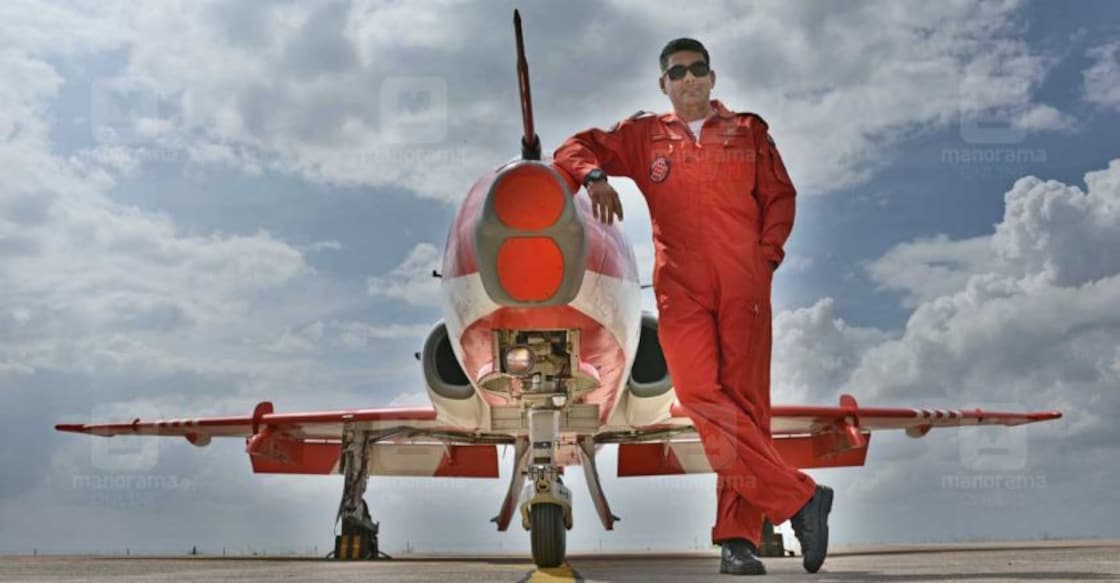Accuracy of a neurosurgeon, a lion's heart, retired Air Force officer recounts flying experience

Mail This Article
As India was preparing to receive the first batch of Rafale aircraft from France, there was a lot of media attention on the fighter pilots, including Wing Commander Vivek Vikram from Ettumanoor, who were entrusted with the task of flying it.
After seeing the five Rafale land in India smoothly, many people wondered: is flying a fighter jet such a big deal after all? Some even wanted to know what fighter pilots do exactly.
To begin with, it is not an easy job. A fighter pilot flies at a speed of more than 2,000 kilometres per hour, without being able to move his arms or legs properly, or even stretch his body when he is tired.
Wing Commander Venu Nambeesan (retd), a former member of Suryakiran Aerobatic Team and joint director of Air Force Intelligence, throws more light on the job of a fighter pilot.
How is the cockpit of a fighter jet?
People mostly have only seen pictures of fighter pilots with aviator sunglasses standing stylishly near an aircraft. But they fly fighter jets in a cockpit that has just enough space for one person to sit.
The cockpit is full of control panels and switches. Even a fraction of a second is valuable to fighter pilots. They have to simultaneously fly the aircraft, communicate with the Air Traffic Control (ATC), check and ensure that the hydraulic-electrical systems are working properly, monitor if they are being detected by enemy radar, examine if there is any variation in the fuel system.
Besides all this is the actual pilot and flight training. Fighter planes in the sky are like an acrobat with an elastic body. The pilot also needs the same flexibility. In military parlance, the fighter pilot needs the accuracy of a neurosurgeon and the strong heart of a lion!
Is there a big difference in flying a passenger plane and a fighter plane?
The only common thing are the basic principles of flying. There is only one pilot in a fighter jet, except in those used for training. Passenger planes have pilots and co-pilots who share the work of flying a plane.
A passenger plane can be put on autopilot after it takes off. The pilots can then rest, have tea, stand up and stretch themselves, or go out to the cockpit to take care of basic needs.
Fighter jets, too, have an autopilot system, but they are not meant to be flown in autopilot. The fighter pilot cannot even move from his seat. The fighter pilot needs a 360-degree view — of the left, right, top and bottom.
The Rafale jets can be refuelled mid-air. Is this an easy task?

Not at all. A giant fuel tanker flies at a certain height in the sky at a certain speed. The fighter jet has to be flown at a certain height close to, and at the same speed of, the tanker for the fuel to be filled.
When you throw a stone in calm water, there will be waves. Similarly, when a large plane is flying, there will be a similar wave in the air surrounding it, although that is invisible. The fighter pilot has to ensure that the jet stays away and doesn’t get caught in that wave.
When the two are flying at the same speed, a fuel hose extends from the tanker to close to the fighter jet. At the front of the fighter jet is an iron tube that extends to receive the fuel. The hose must be inserted into the iron pipe precisely. This is not such a simple job. That’s not all, the fighter jet has to maintain the speed and the height till the fuel is filled.
If it develops a snag, does the Rafale have an escape and an ejection system for the pilots?
Of course, it has. You can say that the pilot of the warplane will be sitting on top of two rockets. The system is attached to the bottom of the pilot's seat for ejection. The system will throw the pilot's seat out of the aircraft frame. Then a parachute will open and the pilot will be able to land safely anywhere.

